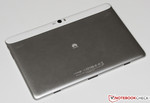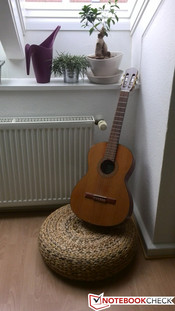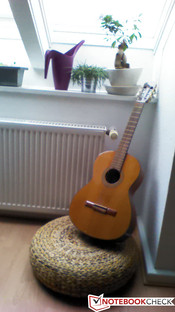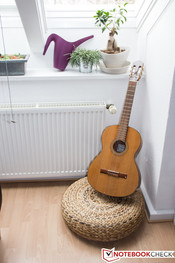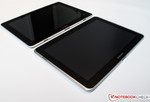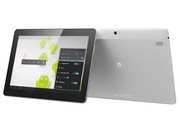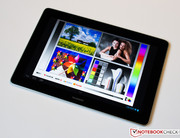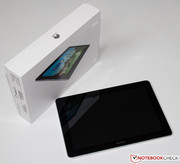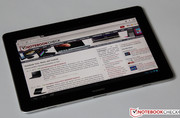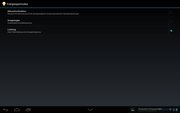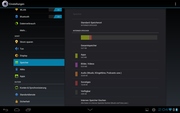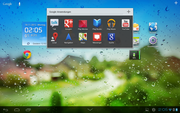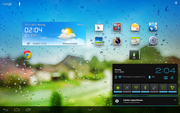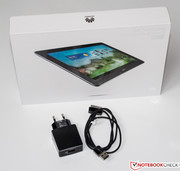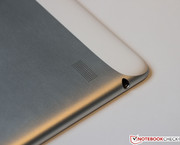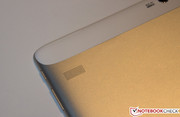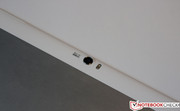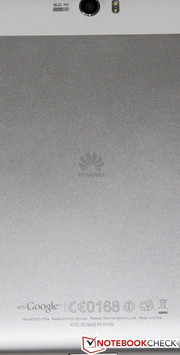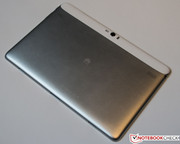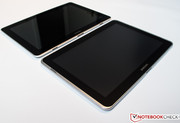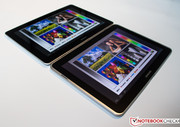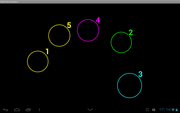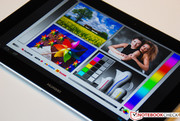Review Huawei MediaPad 10 FHD Tablet

For the original German review, see here.
Huawei is a newcomer on the tablet market with only two other, smaller tablets besides the 10-incher presently in review, and likely an unknown name for many. The manufacturer is slowly but surely expanding its tablet and smartphone portfolio and wants a piece of the big cake. The spec sheet of the MediaPad 10 sounds promising and the tablet could be a sales hit providing that the hardware and software are in sync.
A quad-core with a 1.2 GHz clock frequency and a "16 GHz GPU for graphics" sounds encouraging. The processor dubbed K3V2 is manufactured by a subsidiary called HiSilicon. Nothing stands in the way of multimedia entertainment as it is paired with a Full HD ready screen (1920x1200 pixels) - or maybe there is? Our usual in-depth review will shed light in the dark.
Case
The choice of materials for the smaller MediaPad 7 has apparently been deemed successful and the MediaPad 10 FHD also features a back cover consisting of silver-colored aluminum. The area around the rear-facing, primary camera is made of white polycarbonate to improve the Wi-Fi antenna's transmission among other things. The casing is very stiff but selective pressure visibly dents the aluminum. The workmanship is very satisfactory apart from the pressure resistance. No uneven gaps are found, the display bezel is slightly higher to prevent scratches and the choice of material convinces us.
In contrast to the MediaPad 10's major contenders, it can score with the casing size. Its width is up to 5.6 mm (0.22 inches) narrower than Acer's Iconia Tab A700 (260 x 175 x 10.95 mm/~10.2 x 6.9 x 0.43 inches), Asus' Transformer Pad Infinity TF700T (263 x 180.8 x 8.5 mm/~10.4 x 7.1 x 0.33 inches) and Samsung's Galaxy Note 10.1 (262 x 180 x 8.9 mm/~10.3 x 7.1 x 0.35 inches). A thickness of 8.8 mm (0.35 inches) makes it very handy and pleasant to carry around. Its weight of 598 g (~1.32 pounds) is just as heavy as the Transformer Pad Infinity and even lighter than the other two mentioned tablets.
Connectivity
The most interesting features of the MediaPad 10 are certainly its Full HD screen and the company-made 1.2 GHz quad-core (SoC). We will scrutinize the screen and processor further below. Android 4.0 (Ice Cream Sandwich) is installed in delivery state. Whether an update to the latest Android version is planned and, if so, when is currently unknown. Since it is the newest device from the large-scale Chinese enterprise, it can be assumed that software updates will be available sooner or later. The other key specs have namely become standard for the category. The working memory has a capacity of 2 GB and the internal memory regrettably only features 8 GB. However it can be expanded up to 32 GB via a micro SD slot. 5.67 GB are available after deducting the memory reserved for the system. The primary camera has a resolution of 8 megapixels and the front-facing camera has only 1.3 megapixels.
A 30-pin docking port is located at the device’s bottom, which is also used for recharging. We found product pictures where the MediaPad 10 is docked to a full-blown keyboard including a touchpad on the manufacturer's website. This strongly reminds us of Asus' Transformer range. Unfortunately, we could not find more information about the docking port's options.
Communication & GPS
Huawei covers the standard communication requirements and installs an A-GPS module to enable mobile navigation and other useful features. The module detects GPS satellites within a minute even indoors, but in the vicinity of a window.
Bluetooth version 3.0 is incorporated and the Wi-Fi module transmits using the 802.11 b/g/n standard. We did not observe any connection interruptions in the testing period. In contrast to the MediaPad 7, there is no Full HD version that features a 3G module to-date.
Software
Android 4.2 (Jelly Bean) is already available on some devices, or device-specific updates have been announced. Nevertheless, Huawei's MediaPad 10 FHD comes with Ice Cream Sandwich (4.0). Huawei has modified the well-known Android interface. For example, there is no app drawer (app menu) in the preinstalled launcher. Like in Apple's iOS, all installed apps are mapped to one of the home screens. The user can create folders for a better overview. Most settings have not been changed. However, the user can now choose among three energy-saving modes - battery saving, balanced and performance. This does not affect the clock rate.
The keyboard layout has also been modified slightly. The Android world can be explored in appealing white. Upon inquiry, Huawei Germany could not name a date for software update releases.
Cameras & Multimedia
Huawei follows the competition and installs the two compulsory camera modules in the MediaPad 10 FHD. The first is a high-res, 8 megapixel rear-facing camera and the other front-facing unit is a rather low-res, 1.3 megapixel. Since megapixels alone don’t tell the whole story, we compared our test pictures with a reference camera (Canon EOS 600D with 18 megapixels).
It quickly becomes obvious that the pictures lack focus. The pictures look blurry despite a relatively high resolution of 8 megapixels. The primary camera deals much better with poor ambient light than the front-facing camera, but neither of the cameras can be said to be high-quality. The MediaPad 10 is remote from the fidelity, focus and the balanced color impression of the primary camera in Asus' Transformer Pad Infinity. Unlike the front-facing camera, the 8 megapixel module can be used for making occasional snapshots. Nevertheless, it does a quite decent job as a webcam.
Accessories
There are unfortunately not many accessories found in the attractive packaging. In addition to the tablet, we find a modular power supply unit and a quick start guide. As mentioned above, the manufacturer's website depicts a keyboard in which the MediaPad is docked. We cannot say anything about whether and where such optional accessories are available or about possible prices at the time of this review.
Warranty
Huawei includes a 12-month warranty on its tablet.
Input Devices & Controls
The main control panel is the capacitive touchscreen with a resolution of 1920x1200 pixels. All inputs are implemented precisely and fairly quickly. Like in Asus' Transformer Pad Infinity, the touchscreen control is very satisfactory. The MediaPad 10 detects up to ten fingers at the same time and thus enables use via multi-touch gestures. However, we immediately noticed another similarity with the Pad Infinity: The automatic screen rotation needs a second before turning.
Display
The screen is the main control unit in such an ultra-portable device and one of the primary reasons for buying. Until now, only a few tablets feature a Full HD screen. However, their number will likely increase in the near future. Regrettably, the screen in our test device only achieved a maximum brightness of 249 cd/m². The screen in Asus' Pad Infinity downright shines in comparison (maximum rate: 563 cd/m²). The average brightness rate is consequently only 226 cd/m² at a low illumination of 84%. The MediaPad surpasses the Acer, Asus and Samsung contenders with a black value of 0.22 cd/m². This results in a contrast of 1132:1, which is only topped by Asus' Pad Infinity (1656:1). So, "only" the screen's somewhat weak brightness prevents the IPS screen from excellence.
| |||||||||||||||||||||||||
Brightness Distribution: 84 %
Center on Battery: 249 cd/m²
Contrast: 1132:1 (Black: 0.22 cd/m²)
It is mainly a high maximum screen brightness that counts in outdoor use as it allows seeing content without overstraining the eyes. The trained eye will immediately notice that the MediaPad is on the borderline regarding eye strain. Even Acer's brighter Iconia Tab A700 is very problematic in outdoor use - and that is no different with the MediaPad 10. Frustration increases when distracting reflections from other light sources fall on the screen. The highly reflective screen only intensifies this effect.
The installed IPS screen with Corning Gorilla Glass features very high viewing angle stability for technology-related reasons and ensures saturated colors even in acute angles. However, we noticed that the contrast weakens when the viewing angle increases. To our regret, we detected a pixel error in our test device's screen. This was very obvious particularly on monochromatic backgrounds (black, white).
Performance
Although the spec sheet is available on the manufacturer's website, it does not answer all of our questions. The used SoC (system-on-a-chip) is not yet very widespread and it is difficult to find concrete information about the GPU's performance. Huawei installs a 1.2 GHz quad-core dubbed K3V2 into the Full HD tablet. It is an in-house development of Huawei's subsidiary named HiSilicon and is also used in the telecommunication company's smartphones. The SoC is supported by 2 GB of working memory.
We performed a range of benchmarks with the tablet in order to make first comparisons with other systems. First, the test results based on our subjective impression. The MediaPad showed a more or less poorer performance than the competition in almost all benchmarks. It didn't matter if it was a synthetic or a browser-based test. The hardware installed in Asus' Transformer Pad Infinity as well as in Samsung's Galaxy Note 10.1 is simply much stronger. With a difference of less than 7%, the MediaPad is on a par with Acer's Iconia Tab A700 in some benchmarks. In return, the data rate of the internal hard disk is nearly 10 MB/s faster than the Galaxy Note 10.1 in sequential read access.
Huawei surprises in terms of graphics performance, for example, in GLBenchmark. According to its own specifications, the MediaPad features a "16 core GPU for graphics". GLBenchmark illustrates what this slightly unclear statement means. 18 fps is almost twice the frame rate in GLBenchmark's "Egypt HD Fixed Time" compared with the Galaxy Note 10.1 (9.8 fps). Apple's iPad 4 nevertheless clearly outperforms both in terms of graphics performance.
There is potential in graphics performance, but it would be nice if this performance were also available in other areas.
| GLBenchmark 2.5 | |
| 1920x1080 Egypt HD Offscreen Fixed Time (sort by value) | |
| Huawei MediaPad 10 FHD | |
| Samsung Galaxy Note 10.1 | |
| Acer Iconia Tab A700 | |
| Apple iPad 4 | |
| Egypt HD Fixed Time (sort by value) | |
| Huawei MediaPad 10 FHD | |
| Samsung Galaxy Note 10.1 | |
| Acer Iconia Tab A700 | |
| Apple iPad 4 | |
| AnTuTu v2 - Total Score (sort by value) | |
| Huawei MediaPad 10 FHD | |
| Samsung Galaxy Note 10.1 | |
| Acer Iconia Tab A700 | |
| Asus Asus Transformer Pad Infinity TF700T | |
| Google V8 Ver. 7 - Google V8 Ver. 7 Score (sort by value) | |
| Huawei MediaPad 10 FHD | |
| Samsung Galaxy Note 10.1 | |
| Acer Iconia Tab A700 | |
| Asus Asus Transformer Pad Infinity TF700T | |
| Apple iPad 4 | |
| Sunspider - 0.9.1 Total Score (sort by value) | |
| Huawei MediaPad 10 FHD | |
| Samsung Galaxy Note 10.1 | |
| Acer Iconia Tab A700 | |
| Asus Asus Transformer Pad Infinity TF700T | |
| Apple iPad 4 | |
| AndroBench 3-5 | |
| Sequential Write 256KB (sort by value) | |
| Huawei MediaPad 10 FHD | |
| Samsung Galaxy Note 10.1 | |
| Acer Iconia Tab A700 | |
| Sequential Read 256KB (sort by value) | |
| Huawei MediaPad 10 FHD | |
| Samsung Galaxy Note 10.1 | |
| Acer Iconia Tab A700 | |
* ... smaller is better
Considering the ascertained results, we were a bit surprised that the MediaPad did a good job with playing the trailers of Transformers 3 and Skyfall in Full HD. Stutters or other distracting factors were not an issue during playback. The resolution, the rich colors and the saturated black will provide the eager viewer with a great deal of entertainment.
Games
A contemporary sized quad-core processor and a Full HD resolution - let the fun begin. However, you should not be too hasty and make a binding verdict based on the technical data. It was openly explained in the previous part that the performance could find its limits in sophisticated 3D games. But that is enough speculating. Google's PlayStore offers a multitude of apps and so we looked closer at some games. As presumed, the tablet did not have any problems with undemanding titles like the classic game Angry Birds. Things looked different in GTA III. Maximum resolution and details were not much fun because it was perpetually reloaded and stuttered. It is of course possible to modify the screen's resolution in-game. But who would buy a Full HD tablet only to reduce the resolution - no one actually. We changed the detail level and gameplay was considerably smoother, but not completely devoid of stutters.
Emissions
Temperature
The tablet's temperature assessment in both load and idle reflects our subjective impression. The MediaPad 10 never reached critical temperatures, quite the contrary. We measured a maximum temperature of 32.6 degrees Celsius (~90.7 Fahrenheit) beside the docking port on the right. Even Asus' Transformer Pad Infinity did not do much better with a maximum temperature of 34.2 degrees (~93.6 Fahrenheit), not to mention the 49.3 degrees Celsius (~120.7 Fahrenheit) of Acer's Iconia Tab A700. We measured rates between 26.5 - 30.2 degrees Celsius (~79.7 and 86.4 Fahrenheit) in routine use. The PSU is also absolutely within an acceptable range with a maximum of 40.4 degrees (~104.7 Fahrenheit). We can confirm the MediaPad 10 FHD to have an overall excellent result in temperatures.
(+) The maximum temperature on the upper side is 32.6 °C / 91 F, compared to the average of 33.7 °C / 93 F, ranging from 20.7 to 53.2 °C for the class Tablet.
(+) The bottom heats up to a maximum of 31.3 °C / 88 F, compared to the average of 33.2 °C / 92 F
(+) In idle usage, the average temperature for the upper side is 28.1 °C / 83 F, compared to the device average of 30 °C / 86 F.
Speakers
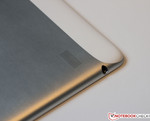
The MediaPad sports two speakers on its back. Stereo sound is basically possible. However, this tablet also struggles with the biggest problem of rear-side speakers: The sound is considerably more muffled and the maximum volume is lower when it is placed on its back. Otherwise, the speakers feature a high volume. We would not recommend permanent music enjoyment at maximum volume though. The sound clearly overdrives, is very tinny and it completely lacks the necessary low ranges due to the build. Huawei also installs a DMS mode (Dolby Mobile Settings), which allows switching between three modes: off, music and movie. We did not notice a difference between the two latter settings. When it is set to off, the maximum volume is lowered and the trebles are reduced. The audiophile tablet user should certainly use the 3.5 mm jack for a satisfying sound experience.
Energy Management
Power Consumption
A lithium-polymer battery with a capacity of 6600 mAh is used in Huawei's MediaPad 10. Huawei does not specify the Watt hours. The tablet was satisfied with an idle power consumption between 1.7 and 6.9 Watts. The Pad Infinity and Iconia A700 are a bit power hungry in comparison (4.6 W - 8.8 W). We observed a similar behavior during load, simulated using the app "Stability Test". With a consumption of 6.9 - 10.4 Watts, the tablet settles between both other Full HD contenders. The tablet is satisfied with 0.1 Watts as soon as it is turned off and 0.2 Watts in standby. Samsung's Galaxy Note 10.1 consumes 0.05 Watts less and Asus' Pad Infinity 0.1 Watt more in both states.
| Off / Standby | |
| Idle | |
| Load |
|
Key:
min: | |
Battery Life
Acer's Iconia Tab A700 features a much higher-capacity battery (9800 mAh). The difference to the Galaxy Note 10.1 is not as large (7000 mAh). The runtime is at least just as long in all test scenarios despite the weaker battery. The tablet shut down after a decent 5 hours and 12 minutes of full load. This was ascertained with the app "Stability Test". However, we found it strange that the app indicated that the SoC only clocked with 800 MHz. This would result in lower power consumption and ultimately explain the long runtime. We could occupy ourselves with the tablet for 6 hours and 57 minutes before the screen went black in the practical Wi-Fi test. A very similar runtime was achieved by Acer's Iconia Tab A700 and Asus' Transformer Pad Infinity. The MediaPad lasts for 14 hours and 48 minutes when all wireless modules are turned off and the screen is set to minimum brightness.
Verdict
The Chinese manufacturer Huawei is launching increasingly more tablets and smartphones on the market. Huawei expands its portfolio with the MediaPad 10 and now offers a 10-inch device after two existing 7-inch tablets.
The design department does not take new approaches in looks. A silver back cover consisting of aluminum is not unusual among other manufacturers. It looks different with the hardware: Huawei does not use universally known hardware like, for example, an SoC from Nvidia and installs still fairly unknown components. The processor comes from HiSilicon, which is a subsidiary. Not everyone will know the GPU either: the Vivante GC4000, a "16 core GPU". Full HD screens are not often seen in tablets at present, thus, it is all the more enjoyable to watch a high definition movie on the rich-color IPS screen. All in all, the MediaPad makes a good impression. However, compromises have to be made. The performance in the benchmarks and in 3D games is unsatisfactory. Asus' Transformer Pad Infinity does not have to struggle with such performance bottlenecks.
Huawei has more or less successfully entered the 10-inch high-end sector. There certainly is room for improvement and it is quite possible that a software update might provide a performance boost. We would hope so anyway. Particularly since the price, which currently starts at approximately 420 Euros (~$553) with a high-res screen, is very attractive for a tablet.




